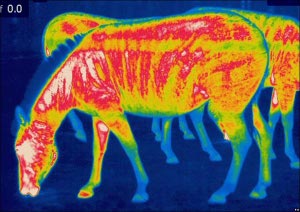 Infrared image of a zebra from the London Zoo.
Infrared image of a zebra from the London Zoo.
Credit: Steve Lowe
Right now I am very excited about the possibility of working on a new small telescope in southern Utah. This telescope was funded by a private donation and will be run by the University of Utah. We even found a mountain top in the middle of nowhere that this telescope will call home.
Why this particular mountain? There are essentially three reasons:
It's dark
It's clear
It doesn't make the stars twinkle
The first two reasons are so obvious that I am almost embarrassed. The last reason is not quite so intuitive. What makes a star twinkle and why do we care? This goes back to a post I made a few months ago.
The basic idea here is that the churning atmosphere blurs your astronomical image. Local geography and weather patterns can either mitigate or exaggerate this effect. It is difficult to predict and many measurements need to be done to determine what is actually happening. Cameras were placed all around southern Utah on various mountain tops to observe the North Star over the course of the year. The mountain top that produced the highest resolution image of the star won the competition. That was Frisco Peak.
